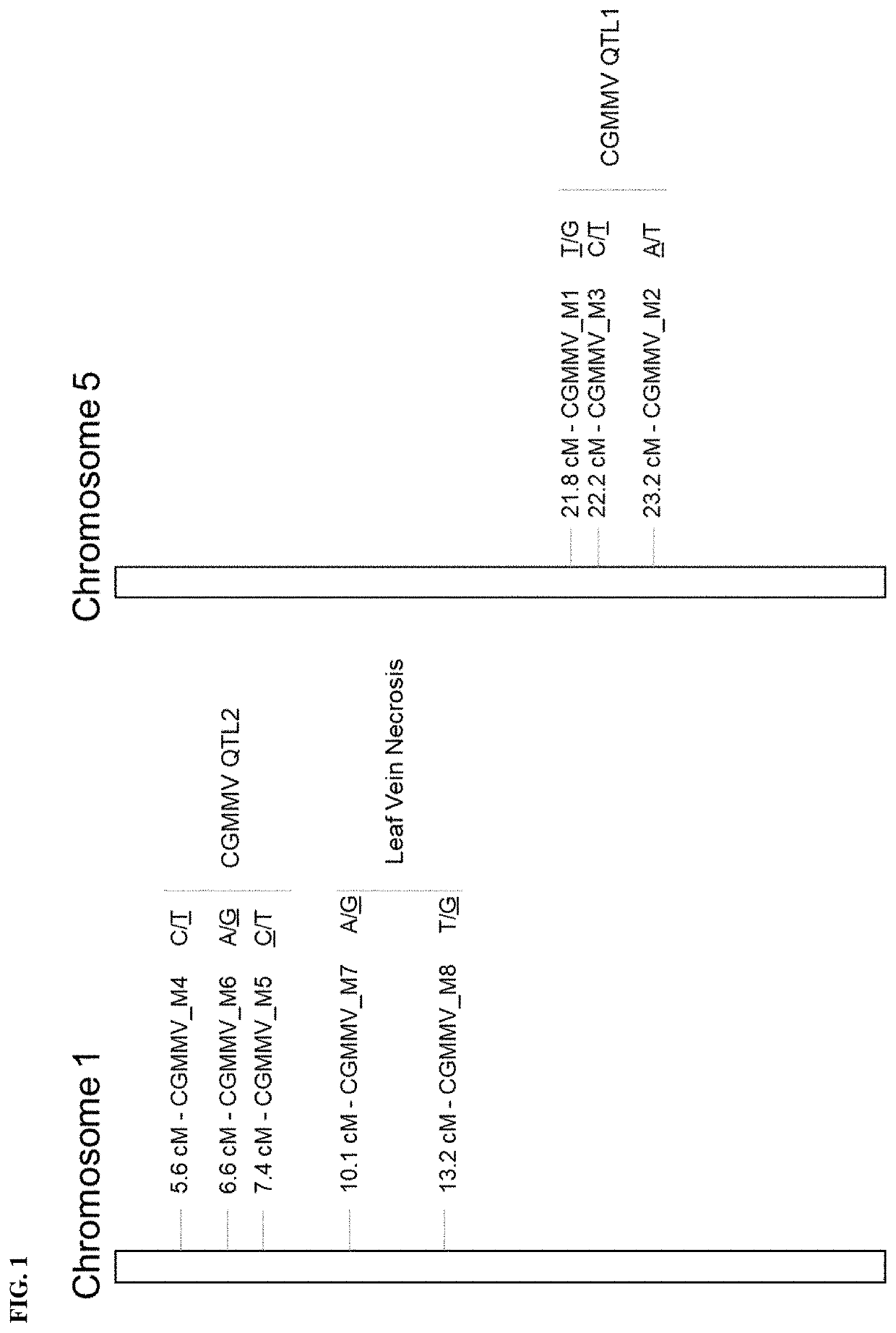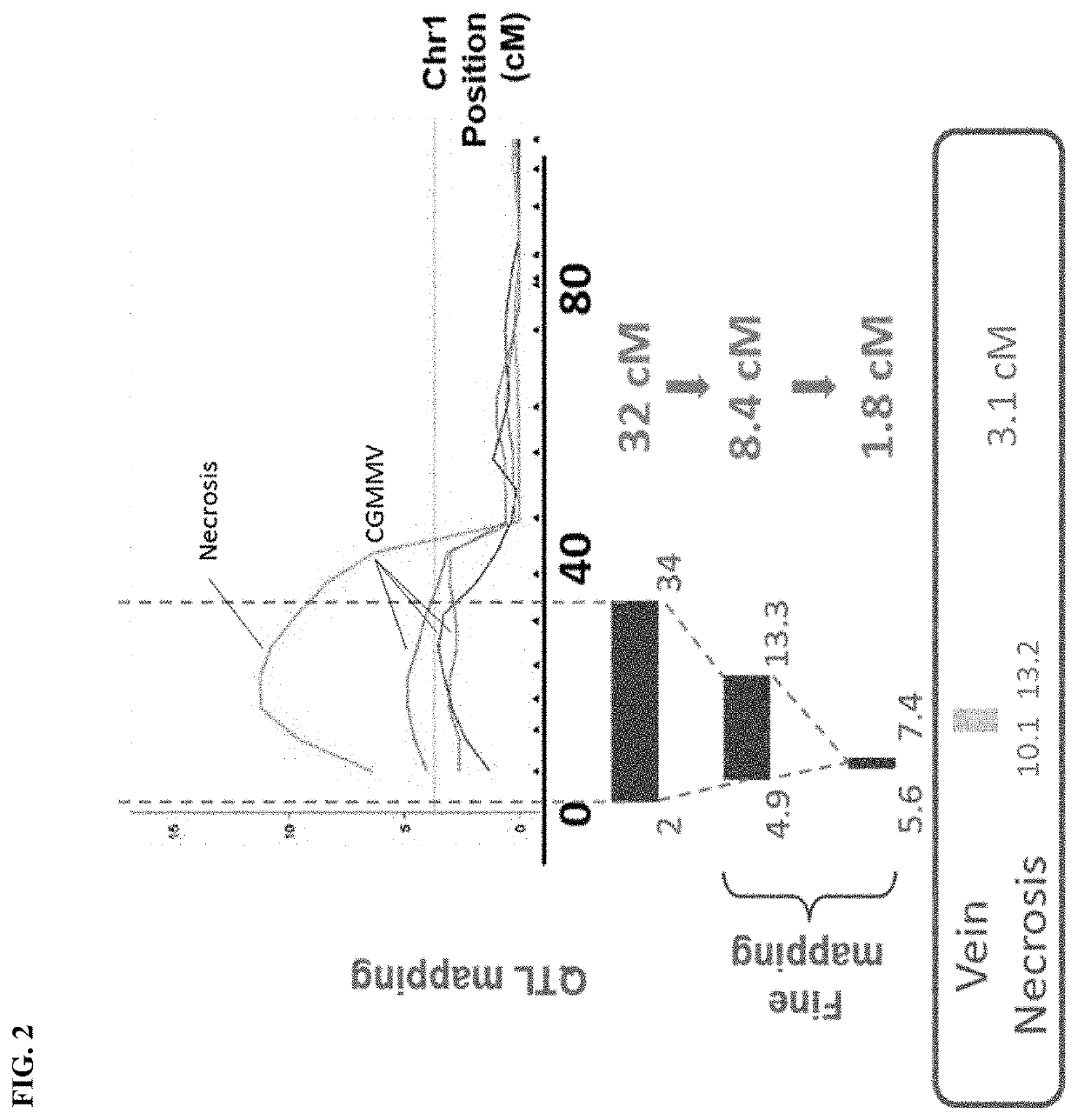Resistance to cucumber green mottle mosaic virus in cucumis sativus
a technology of cucumber, which is applied in the field of resistance to cucumber green mottle mosaic virus in cucumis sativus, can solve the problems of inability to introduce these alleles, lack of high resistance levels, and inability to meet the needs of cultivation, so as to increase the resistance to cgmmv, and increase the resistance to cucumber
- Summary
- Abstract
- Description
- Claims
- Application Information
AI Technical Summary
Benefits of technology
Problems solved by technology
Method used
Image
Examples
example 1
istance Evaluation Assays
[0085]Resistance to CGMMV can be tested in cucumber seedlings and in adult plants. The following method is a cucumber seedling test.
[0086]CGMMV is maintained on susceptible cucumber plants. Young infected leaves can be stored at −20° C. or at −80° C. without losing virus pathogenicity. To prepare inoculum for an experiment, water and carborundum powder is added to leaf material and subsequently crushed using a mortar and pestle or blender. Water is then added to the crushed leaf material in a 1 (leaf material) to 2.5 (water) w / v ratio. For every 100 ml of water added, 2 teaspoons of carborundum powder is also added to the mix. An experiment should be designed using a randomized complete block design with at least three replicates and at least four (preferably 8) plants per genotype in a replicate. In addition, a control set that is mock-inoculated, i.e. with water and carborundum mix only, should be included. The negative control, i.e. susceptible check, can...
example 2
Necrosis Evaluation Assays
[0088]Vein necrosis is a morphological disorder that manifests on cucumber plants as necrosis spots around the veins of mature leaves. The severity of necrosis ranges from small necrotic spots around the main veins to whole leaf necrosis. The development of vein necrosis has been found to be genetic and its expression is influenced by genetic background. Under greenhouse conditions, vein necrosis is often observed in plants from the spring until fall. Because of the variability in vein necrosis manifestation and severity due to genetic background, pedigrees should be trialed in a randomized design, with a minimum of two replicates of four plants. The replicates should be designed to correct for light variation across plant rows. Plants should be grown using double planting rows between paths. Border effects should be reduced as much as possible by applying at least two border plants at the borders of the experiment. Plants can be grown either on perlite or ...
example 3
he CGMMV Resistance QTLs in Cucumber
[0090]CGMMV resistance is controlled by a major quantitative trait locus (QTL) on chromosome 5. Commercial varieties containing the resistance locus on chromosome 5 do not exhibit the same level of resistance to CGMMV that is observed in the wild cucumber accession Cornell Chinese Long. Mapping populations using resistant commercial varieties and Cornell Chinese Long as donor parents were generated to determine the genetic basis of CGMMV resistance in Cornell Chinese Long. The CGMMV resistance locus on chromosome 5 was mapped to a 1.4 cM region between marker loci CGMMV_M1 and CGMMV_M2 (FIG. 1). Marker CGMMV_M1 is a SNP marker with a [T / G] change at 5,704,478 bp of chromosome 5 of the public cucumber genome v2 map. Marker CGMMV_M2 is a SNP marker with a [A / T] change at 6,345,266 bp of chromosome 5 of the public cucumber genome v2 map. Interstitial marker CGMMV_M3 was developed for selection of the CGMMV resistance locus on chromosome 5 and is a SN...
PUM
| Property | Measurement | Unit |
|---|---|---|
| Fraction | aaaaa | aaaaa |
| Volume | aaaaa | aaaaa |
| Electrical resistance | aaaaa | aaaaa |
Abstract
Description
Claims
Application Information
 Login to View More
Login to View More - R&D
- Intellectual Property
- Life Sciences
- Materials
- Tech Scout
- Unparalleled Data Quality
- Higher Quality Content
- 60% Fewer Hallucinations
Browse by: Latest US Patents, China's latest patents, Technical Efficacy Thesaurus, Application Domain, Technology Topic, Popular Technical Reports.
© 2025 PatSnap. All rights reserved.Legal|Privacy policy|Modern Slavery Act Transparency Statement|Sitemap|About US| Contact US: help@patsnap.com


